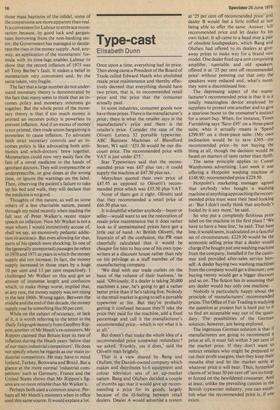Type-cast
Elisabeth Dunn
Once upon a time, everything had its price. Then along came a President of the Board of Trade called Edward Heath who abolished resale price maintenance and thereby effectively decreed that everything should have two prices, that is, its recommended retail price and the price that the consumer actually paid.
In some industries, consumer goods now have three prices. There is the manufacturer's price; there is what the retailer says is the manufacturer's price and there is the retailer's price. Consider the case of the Olivetti Lettera 32 portable typewriter. ABC Business Machines of Blandford Street, WI said: '£51.30 would be our discount price. The recommended price with VAT is just under £75.'
Star Typewriters said that the recommended price was £67 plus tax; it could supply the machine at £47.50 plus tax.
Metyclean quoted their own price of £47.95 as opposed to Olivetti's recommended price which was £55.50 plus VAT.
None of them got it right. Olivetti said that they recommended a retail price of £66.50 plus tax.
It is doubtful whether anybody—buyer or seller—would want to see the restoration of resale price maintenance but it does rather look as if unmaintained prices have got a little out of hand. At British Olivetti, the fountain of all the confusion, the PR man cheerfully calculated that it would be cheaper for him to buy one of his own typewriters at a discount house rather than rely on his privilege as a staff member of the manufacturing company.
'We deal with our trade outlets on the basis of the volume of their business,' he said. 'Obviously, if a dealer is taking 20,000 machines a year, he's going to get a rather better price than if he's taking five. Nobody in the retail market is going to sell a portable typewriter at list. But they're probably getting it confused because they'll take the price they paid for the machine, add a fixed percentage and call it the manufacturer's recommended price—which is not what it is at all.'
But doesn't that make the whole idea of a recommended price somewhat redundant ? we asked. 'Frankly, yes it does,' said the Olivetti man brightly.
That is a view shared by Bang and Olufsen, the Danish-owned company which makes and distributes hi-fl equipment and colour television sets of an up-market nature. Bang and Olufsen decided a couple of months ago that it would give up recommending a price for its goods, largely because of the ill-feeling between retail dealers. Dealer A would advertise a system at '25 per cent off recommended price' and dealer B would feel a little miffed at not being able to offer the same. Answer: kill recommended price and let dealer fix his own ticket. It all came to a head over a pair of obsolete loudspeakers, which Bang and Olufsen had offered to its dealers at giveaway prices to make way for a brand new model. One dealer fixed up a unit comprising amplifier, turntable and old speakers, offered it at '25 per cent off recommended price' without pointing out that only the speakers were reduced and, what's more, they were a discontinued line.
The depressing aspect of the manufacturer's recommended price is that it is a totally meaningless device employed by suppliers to protect one another and to give a spurious boost to the consumer's instinct -for a smart buy. When, for instance, Times Furnishing says 'Save £95' on a three-piece suite, what it actually means is 'Spend £299.95' on a three-piece suite. (My own inclination would be to save £395—the recommended price—by not buying the thing at all, though the decision would be based on matters of taste rather than thrift.
The same principle applies to Comet Warehouses advertising. Last week it was offering a Hotpoint washing machine at £148.90; recommended price £229.50.
Hotpoint's marketing manager agreed that anybody who bought a washing machine at anything approaching the recommended price must want their head looking at : 'But I doh't really think that anybody's fooled by it any more,' he said.
So why put a completely fictitious price label on the machine in the first place? 'We have to have a base line,' he said. That base line, it would seem, is calculated on a fanciful set of circumstances. £229.50 would be the economic selling price that a dealer would charge if he bought just one washing machine from the company, installed it for the customer and provided after-sales service himself. A dealer buying two washing machines from the company would get a discount ; one buying twenty would get a bigger discount and so on. The fiction lies in assuming that any dealer would buy only one machine.
Nobody is particularly happy about the principle of manufacturers' recommended prices. The Office of Fair Trading is studying the question at present but is hard put to it to find an acceptable way out of the quandary. The possibilities of the German solution, however, are being explored.
The ingenious German solution is that if manufacturers are going to recommend a price at all, it must fall within 3 per cent of the market price. If they don't want to restrict retailers who might be prepared to cut their profit margins, then they keep their mouths shut and let the market settle at whatever price it will bear. Thus, hysterical claims of 'at least 50 per cent off' are no longer forced on the bewildered consumer. And at least, unlike the prevailing custom in the British typewriter industry, you can establish what the recommended price is, if one exists.














































 Previous page
Previous page